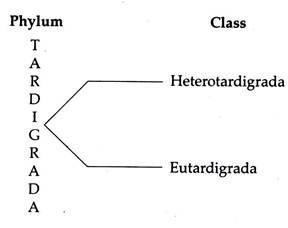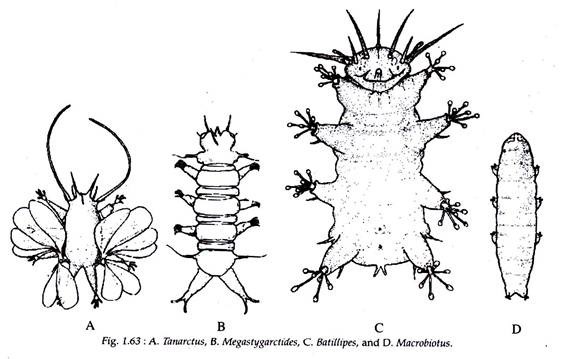In this article we will discuss about Phylum Tardigrada:- 1. Introduction to Phylum Tardigrada 2. Diagnostic Features of Phylum Tardigrada 3. Scheme of Classification 4. Systematic Resume.
Introduction to Phylum Tardigrada:
Phylum Tardigrada comprises of very tiny animals that are highly specialized and commonly known as water bears. They are common and have a rather specialized habitat. They inhabit tiny interstitial regions of beaches, soils, mosses and lichens of marine, fresh water and semiaquatic regions.
Some authors (R. S. K. Barnes, 1998) consider tardigrades as aberrant lobopod pan-arthropods, while Ruppert and Barnes (1994) claim that tardigrades have affinities, evolutionary relationship and aspect of their biology very similar to some aschelminthes.
Etymology:
ADVERTISEMENTS:
Latin: tardus, slow; gradu, step.
Diagnostic Features of Phylum Tardigrada:
i. Bilaterally symmetrical minute body, the length generally 0-3 to 0-5 mm. Some may reach 1-2 mm.
ii. Body more than two cell layers thick, with tissues and organs.
iii. Tardigrade’s body is short, plump and cylindrical, having four pairs of ventral, stubby legs, each terminating into four to eight claws or adhesive discs.
ADVERTISEMENTS:
iv. Body wall with non-chitinous, cuticle- covered epidermis, often bearing spines and/or thickened into plates. Periodically the old cuticle is shed.
v. A fluid-filled pseudocoel extends between the muscle bands and other internal organs.
vi. A straight gut, with a muscular, pumping pharynx bearing chitinous plates (placoids). A pair of buccal stylets can be protracted through the mouth to pierce the prey.
vii. Without circulatory system and gaseous exchange organs.
ADVERTISEMENTS:
viii. Three large glands, sometimes called malpighian glands are present, which are thought to be excretory in function.
ix. Nervous system consists of a brain and paired longitudinal ventral cords bearing leg-associated ganglia.
x. Largely dioecious and have a single saccular gonad, testes or ovary.
xi. Parthenogenesis is common.
xii. Cleavage is holoblastic but does not follow a typical spiral or radial pattern. Development is direct.
Scheme of Classification of Phylum Tardigrada:
There are approximately 600 species of tardigrades and they have been classified into two classes by Ruppert and Barnes (1994).
Systematic Resume of Phylum Tardigrada:
Class Heterotardigrada:
i. These are either marine or terrestrial in habit.
ADVERTISEMENTS:
ii. Body armoured.
iii. Cuticle thickened dorsally and divided into segmental plates.
iv. Conspicuous sensilla on head.
v. Legs stubby, terminating in claws or adhesive discs.
vi. Anus and gonopore separate.
Examples:
Batillipes (Fig. 1.63C), Echiniscus, Stygarctus, Tanarctus (Fig. 1.63A), Mega- stygarctid.es (Fig. 1.63B).
Class Eutardigrada:
i. Body naked comprising of fresh water and terrestrial tardigrades.
ii. Cuticle thin, undivided dorsally.
iii. Head lacks conspicuous sensilla.
iv. Legs terminating in claws.
v. Intestine and gonad open into a common cloaca.
Examples:
Macrobiotus (Fig. 1.63D), Milnesium.

